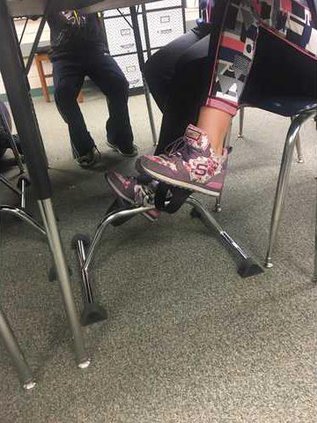All kids have the wiggles even when they are trying to sit still. Instead of fighting that tendency, Priscilla Rose, fourth-grade teacher at Eisenhower Elementary School, is making peace with it.
A visit to her classroom reveals student desks and chairs, but something else as well — alternative seating. “Alternative or flexible seating is not the traditional classroom chair,” Rose said. “Alternative seating is using other seat choices that are best for the students.
“We as adults can relate. How many times does sitting in a boring old chair just pain you,” she asked.
Rose has outfitted her room with eight under-the-desk bike pedals, five stools, three yoga balls, two wobble stools and two chairs with cushions on the seat.
“I chose the different seats to keep the students active and engaged,” she said. “I wanted to integrate sensory options into the students’ day. I thought about what a fourth-grader might need to be successful.”
She decided that allowing them to move more during the day would be helpful. The bike pedals allow the students to move their feet and the balls and wobble stools allow the students to rotate their cores and build their abdominal muscles. The cushions help make seats more comfortable.
The alternative seating options were made possible through classroom funds, personal purchases and a grant.
“Last year, I wrote a DonorsChoose grant for the under-the-desk bike pedals,” she said.
“They are on the floor and give the students a chance to move their feet in order to trigger more engagement and student involvement during the day.
“Each Monday morning the students get to choose their seat for the week. They can ask to move during the week if the seat is not working for them,” Rose explained.
“If I notice they are not making smart choices where they are sitting, I reserve the right to move them.
“I think allowing students make some choices will help them grow not only educationally, but in responsibility as well.
“If they can be responsible for making a smart choice on what is the best seat for them, success will be more reachable for them.
Rose said the outcome is that students are more engaged and are learning while moving.
“There are not too many problems,” she noted. “I have had to adjust my tolerance for little noises that the pedals sometimes make.”
Flexible learning styles
Alternative seating helps kids be kids





